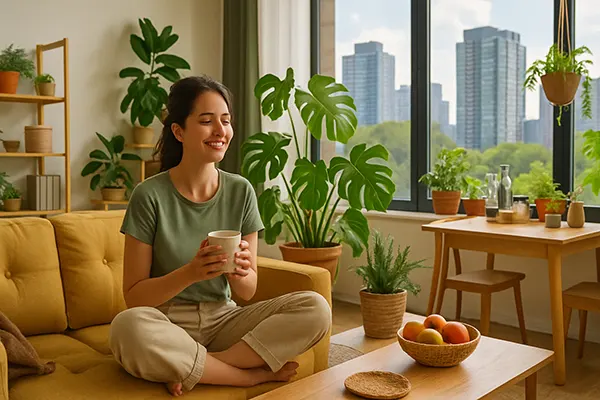
Living with Less in a World of More: Urban Eco-Minimalism in 2025
In 2025, as cities continue to expand and consumerism dominates our daily routines, the concept of minimalism has taken on a new, environmentally conscious dimension. Urban eco-minimalism is not just a design trend; it’s a lifestyle shift that encourages living with less in order to reduce waste, consumption, and carbon footprints. This form of minimalism adapts traditional values to the complex urban landscape, where space, time, and resources are often limited.
Rather than aspiring to accumulate material possessions, eco-minimalism invites city dwellers to prioritise sustainability, ethical choices, and quality over quantity. It promotes smart consumption habits, second-hand living, and functional aesthetics. This trend is not only practical but also reflects a growing societal shift towards environmental responsibility and mindful living in urban environments.
The movement’s relevance has never been more significant. Climate reports published in early 2025 by the European Environment Agency highlight urban overconsumption as one of the leading contributors to greenhouse gas emissions. In response, eco-minimalist living offers a tangible way for individuals to take action without sacrificing comfort or personal style.
Why Eco-Minimalism Matters in Cities Today
Living in a densely populated city can make the idea of minimalism seem challenging. Urban areas often encourage fast living—fast food, fast fashion, and fast furniture. However, this same environment is also where the most profound environmental impact can be made. By adopting eco-minimalist habits, individuals can combat the waste and pollution typically generated in city life.
Eco-minimalism supports conscious decisions such as limiting single-use plastics, using public transportation, and living in smaller, energy-efficient homes. These choices not only benefit the environment but can also lead to a clearer, less cluttered mind. With space at a premium, urban dwellers benefit greatly from reducing unnecessary items and focusing on what truly adds value to their lives.
In 2025, several metropolitan governments across Europe—including Amsterdam, Copenhagen, and Vienna—have introduced policies promoting circular economies and reduced household waste. These initiatives encourage residents to embrace minimalism as both an environmental and economic necessity. Minimalist living helps citizens align with local sustainability goals while improving their own quality of life.
Real Benefits of an Urban Eco-Minimalist Lifestyle
Urban eco-minimalism isn’t about deprivation—it’s about intentionality. Choosing items that serve multiple purposes, investing in long-lasting goods, and supporting local eco-conscious businesses create a lifestyle that is both satisfying and sustainable. Minimalism offers mental clarity, financial savings, and environmental peace of mind.
Clutter is proven to increase stress and reduce focus, especially in cramped urban flats. Embracing minimalism means creating calming spaces that reflect purpose, not excess. Eco-conscious furniture brands such as EcoBirdy and Tylko have gained popularity in 2025 for offering customisable, modular pieces made from recycled materials—perfect for the minimalist city dweller.
Another key benefit is community engagement. Swapping events, urban composting schemes, and shared gardens have gained traction as minimalist alternatives to ownership. These initiatives foster a collective urban culture that values contribution and sustainability over consumption.
Style Without Shopping: Sustainable Fashion for City Life
Eco-minimalism also influences how urban residents dress. In 2025, sustainable fashion has evolved from a niche market into a cultural movement. Instead of following fleeting trends, many are turning to curated capsule wardrobes, renting instead of buying, and shopping vintage as a way to express identity while reducing textile waste.
Major fashion capitals like London and Berlin now host annual circular fashion fairs, where upcycled garments and zero-waste collections take centre stage. Mobile apps such as Vinted, Good On You, and By Rotation have further simplified access to ethical clothing, helping users align their wardrobes with their values without compromising on aesthetics.
This approach proves that style and sustainability are not mutually exclusive. A well-maintained wardrobe of 30–40 high-quality pieces can serve almost every social, professional, and casual occasion. The new urban dress code is smart, sustainable, and intentional—a mirror of the eco-minimalist ethos.
How to Build a Conscious Wardrobe
Start with what you already own. Many people rediscover lost favourites by decluttering and re-evaluating their current clothing. Create a capsule collection of versatile pieces that complement one another in colour and function. Quality natural fabrics such as organic cotton, linen, and recycled wool are excellent choices for durability and comfort.
Seek brands that offer transparency in sourcing and production. In 2025, companies like Patagonia, People Tree, and Stella McCartney continue to lead the charge with responsible materials and fair labour practices. Read labels, ask questions, and prioritise ethical values when making new purchases.
Finally, learn to care for your clothes. Proper washing, storage, and repair significantly extend the life of garments. Consider taking a mending workshop or following tutorials on visible mending—a popular craft movement that transforms repairs into stylish statements. Sustainability starts with valuing what you already have.

Minimalist Homes for Maximum Impact
In urban eco-minimalism, your home becomes both sanctuary and statement. City apartments are often compact, and minimalism helps maximise functionality without sacrificing comfort. In 2025, the trend leans towards biophilic design, integrating plants, light, and natural materials to create calm, inviting interiors.
Swapping bulky furniture for modular, space-saving alternatives is key. Foldaway desks, floating shelves, and multi-use storage make even the smallest homes feel spacious. Natural tones and uncluttered layouts enhance relaxation and reduce mental fatigue—vital in fast-paced city life.
Incorporating sustainable materials—bamboo flooring, cork panels, and reclaimed wood—brings character and responsibility into the home. Smart energy-efficient appliances and water-saving fixtures further reduce the environmental footprint, making the home a cornerstone of urban ecological living.
Daily Habits for a Greener Home
Declutter regularly and mindfully. Don’t just throw things away—donate, repurpose, or recycle responsibly. Practice conscious purchasing by asking: “Do I need this?” and “Can I get it second-hand?” Reducing waste begins at the decision-making stage.
Implement zero-waste strategies like composting kitchen scraps and using refillable containers. Many cities in 2025 now offer dedicated refill stations and community composting hubs. Participating in these not only lessens landfill contribution but also connects you to like-minded locals.
Lastly, reduce energy use by embracing natural light, using LED bulbs, and unplugging idle electronics. Smart thermostats and energy monitors help track usage and lower bills. Living with less doesn’t mean sacrificing comfort—it means choosing smarter, greener habits that make city life more sustainable for everyone.
